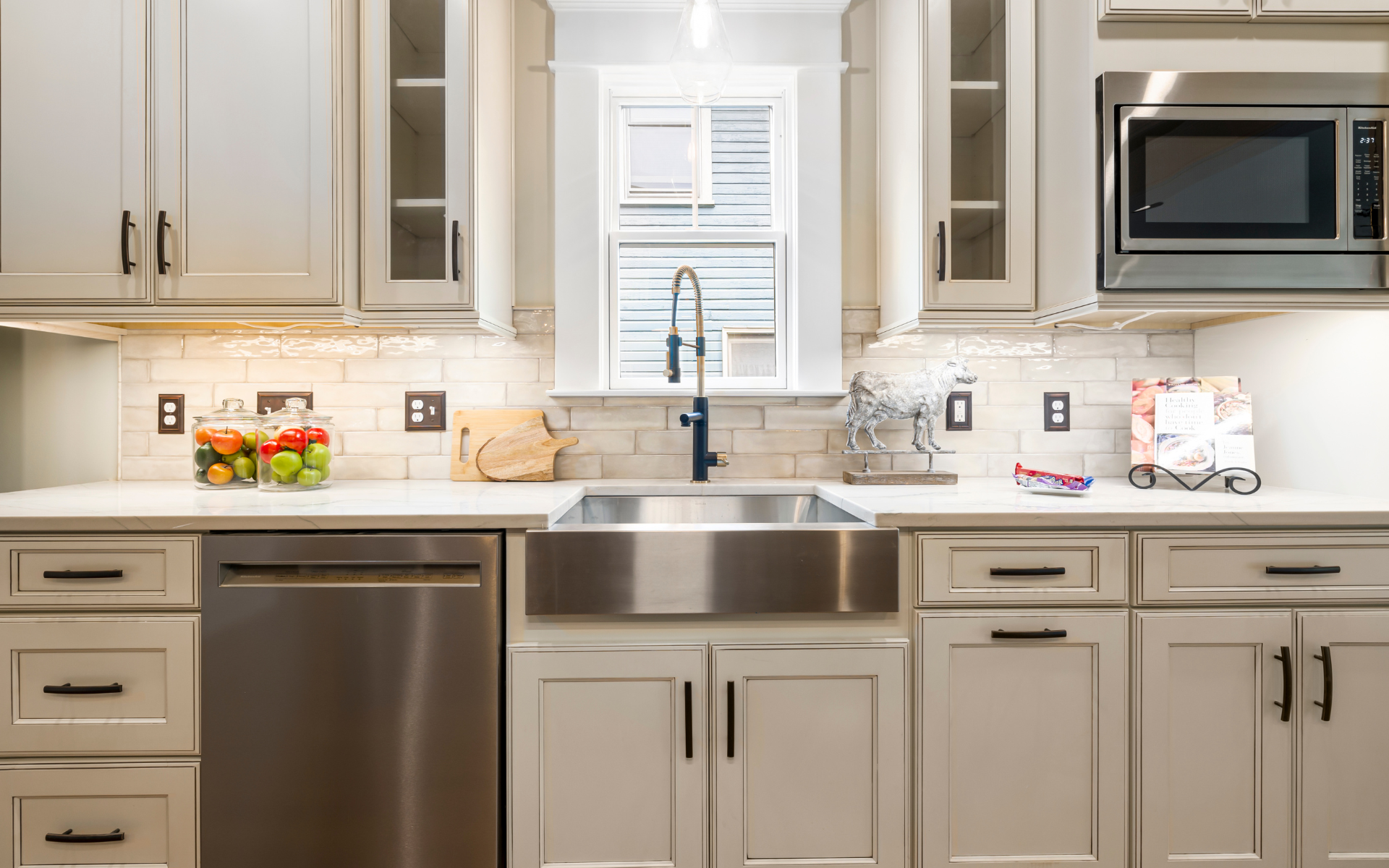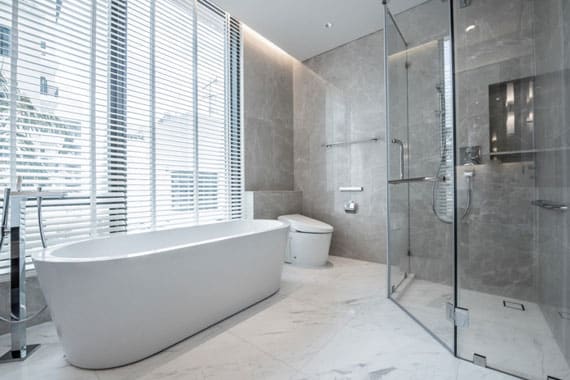Thinking about updating your kitchen means tackling one major expense, which is cabinetry. In fact, most homeowners spend 30 to 40 percent of their total kitchen budget on new kitchen cabinets alone. Avoid spending problems later by getting this number right from the start.
Working with a trusted kitchen remodeling company makes the process easier. Actually, professional guidance helps you navigate options, avoid common mistakes, and get the best value for your investment. Let’s break down what you need to know about new kitchen cabinets and how to spend your money wisely.
Table of Contents
What Drives the Cost of New Kitchen Cabinets
Your purchase price is based on several things. Above all, size matters most. A small galley kitchen needs fewer cabinets than a large open-concept space with an island.
Here’s how cabinet type affects your budget:
- Stock cabinets offer the most affordable option at $100 to $300 per linear foot
- Semi-custom options provide more flexibility at $200 to $650 per linear foot
- Custom builds deliver exact specifications at $500 to $1,200 per linear foot
According to Angi‘s 2025 data, most homeowners spend between $1,978 and $11,043 on cabinet installation, with an average of $6,317 for a complete kitchen. Interestingly, location plays a role too. Installing new kitchen cabinets in urban areas costs more than rural installations due to higher labor rates.
When it comes to materials, the difference in pricing is significant. Solid wood costs more than laminate or thermofoil. Beyond that, your choice of kitchen cabinet styles impacts both the upfront cost and long-term value. For instance, Shaker-style cabinets remain popular for their clean lines and reasonable prices, while ornate designs with detailed molding push costs higher.
Breaking Down New Kitchen Cabinet Installation Costs
In most cases, labor accounts for 20 to 30 percent of your total project cost. On average, professional installers charge $50 to $250 per hour, depending on your location and project complexity. Sometimes they charge per linear foot at $100 to $300 instead.
Typically, installation time depends on kitchen size and complexity. For standard kitchens, professionals need one to three days. On the other hand, complex layouts with specialty units or custom closets need more time and increase labor costs.
Permits add $50 to $400 when structural changes or electrical work are involved. Generally, your installer handles permit applications, but factor this into your budget for new kitchen cabinets.
As for hardware and add-ons, items like soft-close hinges, pull-out organizers, or under-cabinet lighting cost $20 to $200 per cabinet. Sure, these extras improve function and comfort, but they add up quickly across multiple units.
How Much Should You Actually Spend
First, start by calculating your kitchen size. Measure the linear footage of wall space where cabinets will go. Don’t forget to include base cabinets, wall cabinets, and any specialty pieces like pantries or islands.
Here’s what the project scope determines for spending:
- Small kitchens (10 to 15 linear feet): $3,000 to $6,000
- Medium kitchens (20 to 30 linear feet): $6,000 to $12,000
- Large kitchens (35+ linear feet): $12,000 to $25,000+
Ideally, match your spending to your home value. Real estate experts suggest spending 10 to 15 percent of your home’s value on a full kitchen remodeling project. Within that budget, cabinets should take up about one-third.
Also, think about how long you plan to stay in your home. Spending more on quality new kitchen cabinets makes sense if you’re staying 10+ years. Meanwhile, choose mid-range options if you plan to sell within five years. According to Houzz‘s 2025 Kitchen Trends Study, homeowners report the highest satisfaction when they invest in quality materials that match their lifestyle needs.
Beyond that, consider your cooking habits too. Frequent home cooks benefit from custom storage solutions and durable materials. On the flip side, light users might do fine with stock cabinets and basic features.
Finding What Type of Cabinet is Right for You
Stock
For standard kitchen layouts and tight budgets, stock cabinets work well. Essentially, these pre-made units come in fixed sizes and limited finishes. Better yet, you get fast delivery, usually within days or weeks. Now, quality varies by manufacturer, but premium stock options from Forevermark Cabinetry or Fabuwood deliver solid construction at reasonable prices.
Semi-Custom
As for semi-custom cabinets, they offer the sweet spot for many homeowners. Here, you choose from various sizes, finishes, and features without paying custom prices. Keep in mind, lead times run longer at 4 to 8 weeks. Still, this option suits most kitchen layouts and provides enough flexibility for personal style.
Custom Kitchen Cabinets
When it comes to custom cabinets, they fit any space perfectly and offer unlimited design choices. Basically, you pick everything from wood species to door styles to internal organization. Of course, expect to wait 8 to 16 weeks for delivery. In reality, this choice makes sense for unique layouts, luxury homes, or when you want specific kitchen cabinet ideas brought to life.
By the way, factory-direct kitchen cabinet purchases cut out the middleman and reduce costs. Actually, buying directly from manufacturers saves 20 to 40 percent compared to big-box retailers.
New Kitchen Cabinet Trends Worth the Investment
Right now, two-tone cabinets create visual interest and add personality to kitchens. Actually, this new trend for new kitchen cabinets typically involves using one color for base cabinets and another for uppers or islands. Yes, the look costs slightly more due to additional materials and coordination, but it delivers strong design impact.
As for hidden storage solutions, they maximize every inch of space. For example, pull-out spice racks, corner lazy Susans, and drawer organizers cost extra but improve daily function. Clearly, these features make cooking and cleaning easier, especially in smaller kitchens.
Meanwhile, sustainable materials are gaining popularity among eco-conscious homeowners. Think bamboo, reclaimed wood, and low-VOC finishes. Granted, they cost 10 to 20 percent more but reduce environmental impact. Fortunately, many manufacturers now offer green options without sacrificing quality or style.
When it comes to smart storage technology, options include touch-to-open doors, LED lighting systems, and charging stations built into cabinets. Typically, these upgrades run $200 to $500 per feature but appeal to tech-savvy buyers and improve resale value.
Also popular, open shelving mixed with closed cabinets creates an airy feel while maintaining storage. Actually, this approach costs less than all-cabinet installations and works well for displaying dishes or decorative items.
Tips to Reduce New Kitchen Cabinet Costs
For starters, refinishing existing cabinets costs 50 to 75 percent less than full replacement. In fact, this works when cabinet boxes are structurally sound but doors and finishes look dated. Simply adding new doors and hardware creates a fresh look at a fraction of the price.
Another tip: keep your existing layout to avoid moving plumbing or electrical. Truth is, relocating sinks, dishwashers, or outlets adds thousands to your project. Whenever possible, work within your current footprint.
Here are some budget-friendly strategies:
- Mixing cabinet types by using custom pieces for focal points and stock cabinets elsewhere
- Installing open shelving in some areas to reduce cabinet needs
- Choosing simple door styles over ornate designs
- Selecting standard depths and heights instead of custom dimensions
Also, shop sales and clearance events. Often, many manufacturers offer discounts on discontinued colors or styles. Sure, these cabinets work perfectly fine but cost less because they’re being phased out.
Always get multiple quotes from at least three installers. Remember, prices vary widely, and comparing helps you find the best value. Plus, ask about package deals if you’re doing other kitchen remodeling work at the same time.
Finally
Before deciding, visit showrooms to see and touch different cabinet options. After all, photos don’t capture quality differences in construction or finishes. By seeing materials in person, you’ll make confident choices about what works for your space.
In the end, the cost to have new kitchen cabinets installed represents a significant investment in your home’s function and value. You can make a kitchen that fits your wants and your budget if you know what affects prices and make wise choices about materials and features. No matter if you choose stock, semi-custom, or custom cabinets, they will give you years of happiness if they are installed well and with care.
Are you ready to begin organizing your cabinet project? For a FREE estimate based on your specifications, get in touch with Dupont Design Center.


